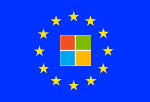The full text of the letter is reproduced below.
To: Commissioner Cecilia Malmstroem (Home Affairs)
cc: Antonio Tajani (Enterprise)
Viviane Reding (Justice)
Joaquin Almunia (Competition)
Michel Barnier (Internal Market)
Neelie Kroes (Digital Agenda)
Dear Commissioner Malmstroem,
we are writing to you on the occasion of the international Day Against Digital Restrictions Management, which today is being celebrated around the world. We are very concerned about the security of European citizens, and we ask you to take action to protect them.
The Free Software Foundation Europe (FSFE) is an independent charitable non-profit dedicated to promoting Free Software and freedom in the information society. Today we would like to direct your attention to a very specific threat to the freedom and security of computer users everywhere.
Both at work and in our personal lives, we conduct a large part of our activity through Web browsers. Ever more of our work and life migrates into the digital domain, and many people use a growing number of web services to work, create, socialise, and express themselves. Businesses and public sector organisations similarly rely on web browsers as crucial tools to perform their everyday tasks.
Recently, the importance of the Web browser was highlighted when numerous state agencies and IT security companies warned about a long-standing critical security problem in the widely used Microsoft Internet Explorer browser, soon followed by warnings of a vulnerability in the also widely used Adobe Flash Player.
These incidents were only the most recent ones to highlight the importance of ensuring that such a crucial piece of software as the Web browser is fully under the control of its user. The German Federal Office of Information Security (BSI) issued a list of recommendations for secure Web browsers and their components for use in companies and public bodies on April 14. The BSI notes that due to the way they are used, “Web browsers are exposed to especially high risk from malware”. In the list of recommendations for a secure Web browser, the BSI includes the demand that Web browsers and their components should be completely auditable (Point 1.6).
Web browsers like Mozilla Firefox or the Chromium browser have succeeded in this regard, providing the public with web browsers that are not only fully auditable, but which can also be freely shared and improved. This is in line with the Open Standards approach which has made it possible for the Internet and the World Wide Web to thrive and grow into its current role as a vital platform for economic activity, social interaction without borders, and unchained creativity.
The protocols on which the Internet is built, such as the TCP/IP stack and the HTML standard, are fully open and implemented in myriad Free Software products. Free Software powers the vast majority of Web servers, smartphones, embedded devices, and many other applications of technology. The rise of today’s leading Web companies, such as Google, Facebook, and Amazon, would not have been possible without Free Software, and they could not operate without it today. Whatever European companies step up to challenge them are inevitably going to rely on Free Software and Open Standards as well. Free Software and Open Standards are both the foundation of our digital world, and the condicio sine qua non for its future.
HTML5 is the latest revision of the HTML standard. It is hard to think of a standard that is more crucial for the World Wide Web. HTML5 will deliver a number of important improvements, and is set to be the basis of the World Wide Web for the coming years, and to allow for the kind of rich, responsive interactivity that will allow browsers to replace “apps” as controllers for everything from thermostats to automobiles.
This is why we are very concerned about efforts currently in progress at the World Wide Web Consortium, which oversees many of the key standards on which the Internet and the World Wide Web are based, to encourage use of the Content Decryption Module (CDM) which cannot be audited. The CDM, though not specified in the HTML5 standard itself, is required by the so-called “Encrypted Media Extension” (EME), developed by a W3C working group. This extension’s primary purpose is to satisfy the desire of a limited number of content providers with traditional business models to generate revenue through restrictive distribution practices. With EME, the W3C would be building a bridge to let content providers take control of users’ computers, letting them impose restrictions far in excess of what consumers’ rights and copyright allow.
The discussion about EME at W3C is largely driven by a few large US-based companies, and except the BBC takes place without significant European involvement. Given these circumstances, the discussion will likely result in a solution that fails to take the needs of European citizens, businesses and governments fully into account.
Auditing the Content Decryption Module will be difficult, because the source code of this functionality will be a closely held secret of the company which provides it. Performing such an audit and reporting security flaws would also be illegal in the many countries which have adopted so-called “anti-circumvention” laws. Reporting a security problem in CDM would expose the reporter to the risk of prosecution for making a circumvention device.
In consequence, individuals, companies and organisations (including the European Commission) would likely end up increasing the amount of software with unknowable security problems which it uses in a high-risk setting.
Integrating DRM facilities into HTML5 is the antithesis of everything that has made the Internet and the World Wide Web successful. It is directly contrary to the interests of the vast majority of Internet users everywhere, and especially in Europe.
Recommendations
The discussions within W3C are now at a crucial juncture in this regard. It is still just about possible to prevent the W3C from making it too easy to effectively require the inclusion of such secret, inauditable software in Web browsers.
- We urge the Commission to engage with the W3C and ensure that the organisation takes these concerns on board as it decides on the adoption of the Encrypted Media Extension (EME).
- We further ask the Commission to underline its commitment to the security and freedom of Europe’s citizens by pledging not to make use of the Encrypted Media Extension in its own infrastructure, even if EME would be standardised by W3C.
- At a minimum, the W3C should require covenants from EME participants through which they promise not to take action against entities who report and demonstrate vulnerabilities in EME and the CDM; and covenants to safeguard entities who reverse-engineer and publish details of EME and CDM implementations for the purpose of interoperability, including interoperability with Free Software.
At FSFE, we look forward to supporting the Commission in taking the appropriate actions to safeguard the interests of Europe’s citizens and companies, and remain at the Commission’s service.
Sincerely,
Karsten Gerloff, President Free Software Foundation Europe
 The European Commission has recently renewed its commitment to a proprietary desktop and secret file formats, the Free Software Foundation Europe (FSFE) writes. The Commission is refusing to make a serious effort to break free from vendor lock-in and is ignoring all available alternatives. In doing so, the EU’s civil service fails to practice what it preaches.
The European Commission has recently renewed its commitment to a proprietary desktop and secret file formats, the Free Software Foundation Europe (FSFE) writes. The Commission is refusing to make a serious effort to break free from vendor lock-in and is ignoring all available alternatives. In doing so, the EU’s civil service fails to practice what it preaches.

 Several universities and companies are working collaboratively in the Ossmeter research project on a platform for evaluating and comparing open source software. The European Union is funding Ossmeter’s development to the tune of €2.6 mn. (out of total project costs of €3.4 mn. Ed.) and the software that is ultimately developed will be made available online as a free service and released as free software so it can also be deployed as an in-house quality management tool.
Several universities and companies are working collaboratively in the Ossmeter research project on a platform for evaluating and comparing open source software. The European Union is funding Ossmeter’s development to the tune of €2.6 mn. (out of total project costs of €3.4 mn. Ed.) and the software that is ultimately developed will be made available online as a free service and released as free software so it can also be deployed as an in-house quality management tool. The developers of the
The developers of the  On Friday evening the
On Friday evening the 
 The
The